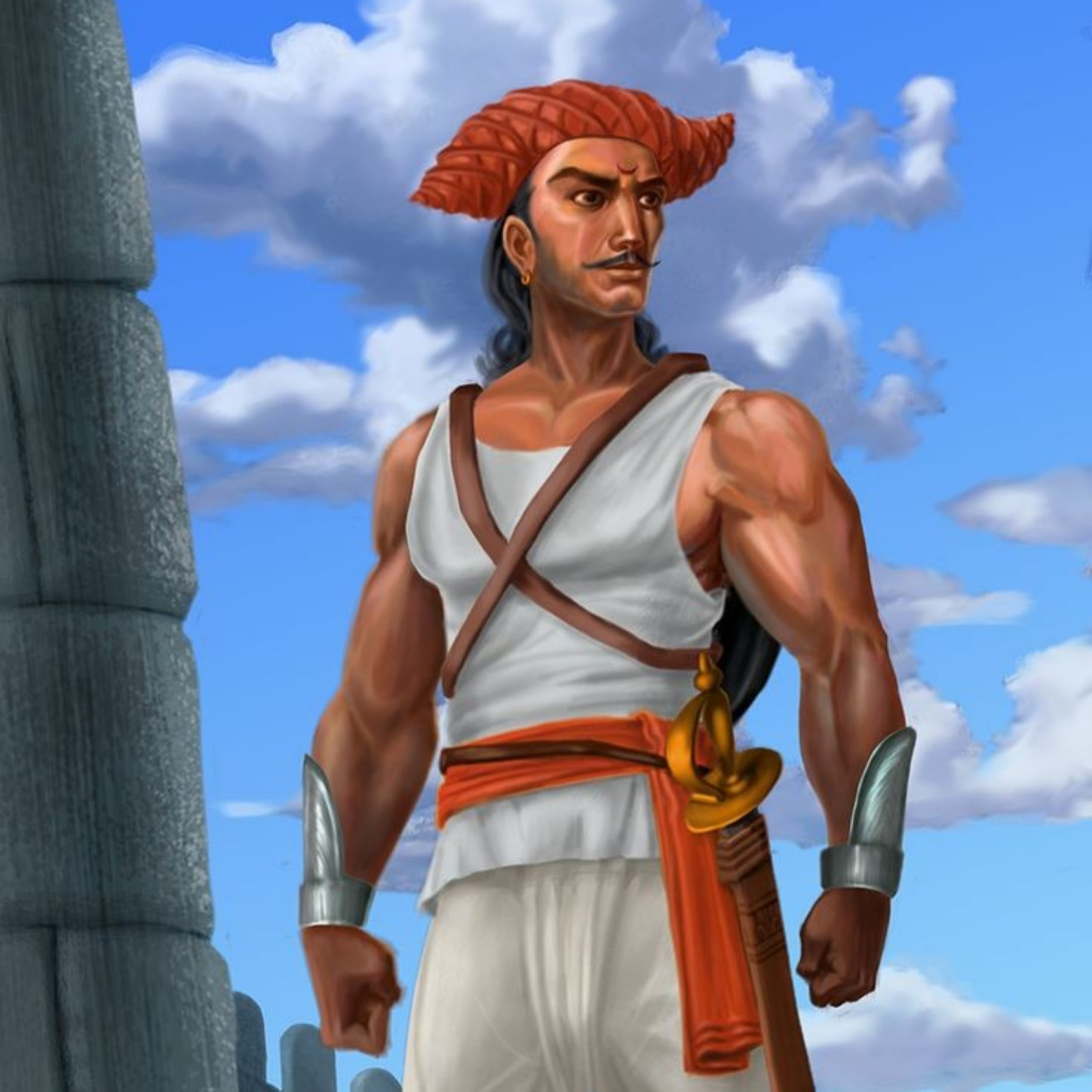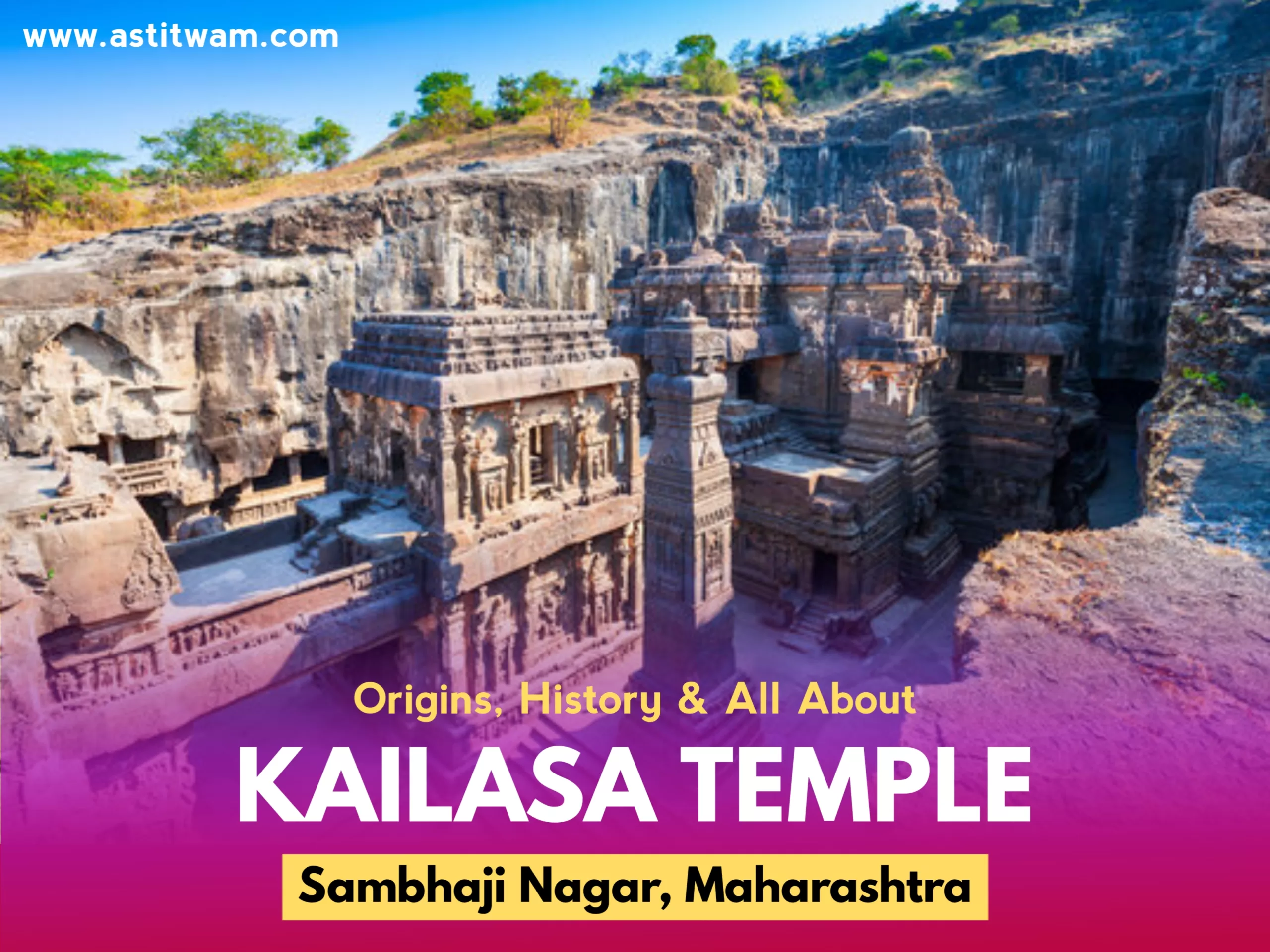Sree Padmanabhaswamy Temple | Thiruvananthapuram, Kerala
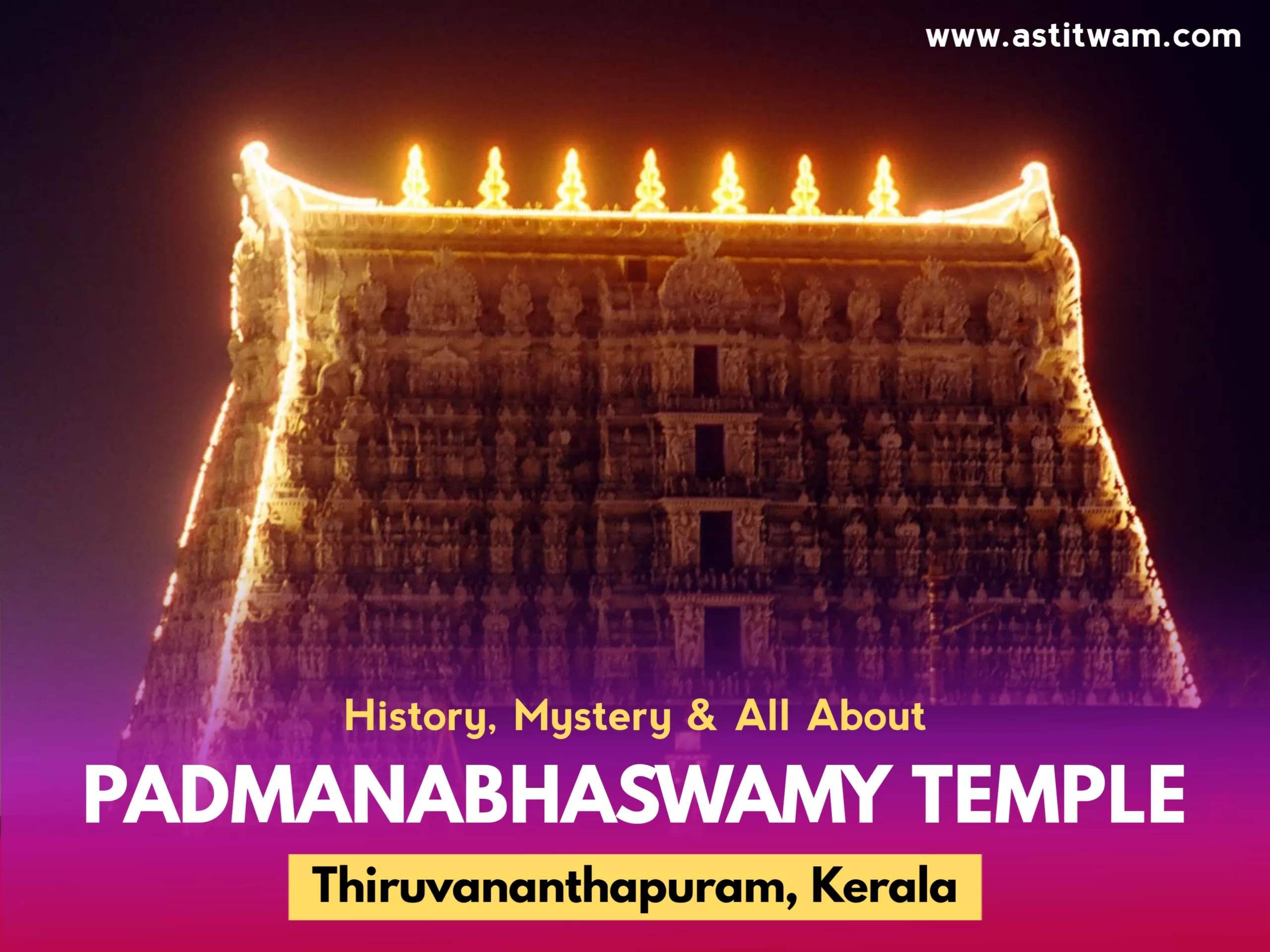
Table of Contents
Overview

The Sree Padmanabhaswamy Temple in Thiruvananthapuram, Kerala, is a Hindu temple dedicated to Vishnu. It’s known as one of Vishnu’s sacred homes, and many say it’s the richest Hindu temple in the world. The name of the city, ‘Thiruvananthapuram,’ means “The City of Ananta” in Malayalam and Tamil, which is a form of Vishnu. The temple combines Kerala and Dravidian styles of architecture, with tall walls and a 16th-century gopuram. While some believe the Ananthapura temple in Kumbla, Kasaragod district, is the original spiritual home, architecturally, it’s quite similar to the Adikesava Perumal temple in Thiruvattar, Kanyakumari district, Tamil Nadu.
[devvn_ihotspot id=”2815″]
The main deity here is Padmanabhaswamy (Sanskrit: पद्मनाभस्वामि, IAST: Padmanābhasvāmi), a form of Vishnu lying in the “Anantashayana” posture, in eternal yogic sleep on his serpent mount, Shesha. Padmanabhaswamy is the special deity of the Travancore royal family, and the current trustee of the temple is the titular Maharaja of Travancore, Moolam Thirunal Rama Varma.
Sree Padmanabhaswamy Temple History

I. Historical Mentions and Significance:
Various extant Hindu texts such as the Vishnu Purana, Brahma Purana, Matsya Purana, Varaha Purana, Skanda Purana, Padma Purana, Vayu Purana, and Bhagavata Purana all make mention of the Padmanabhaswamy Temple. These ancient texts provide a foundation for the historical and religious significance of the temple, indicating its presence and importance across different periods of Hindu literature and mythology.
The Padmanabhaswamy Temple is notably referenced in the Sangam period literature, which is a collection of ancient Tamil literature dating back to around 300 BCE to 300 CE.Despite the scarcity of recorded information from this era, the temple’s repeated mention suggests its prominence and relevance during the Sangam period.Scholars and historians speculate that the epithet “The Golden Temple” attributed to the Padmanabhaswamy Temple reflects its extraordinary wealth even during the early Sangam period.This title underscores the temple’s immense prosperity, possibly indicating its status as a center of opulence and religious patronage in ancient times.
Sangam Tamil literature and later compositions by Tamil poet-saints, such as Nammalwar from the 9th century CE, vividly describe the temple and the city where it stands. These literary works portray the temple and its surroundings as opulent and divine, often depicting them as being constructed entirely of gold and equating the temple with heaven itself.
The temple’s portrayal in ancient texts and literature reflects its enduring cultural and religious significance within the Hindu tradition. Through textual references and poetic depictions, the Padmanabhaswamy Temple emerges as not only a physical edifice but also a symbol of spiritual grandeur and cultural heritage cherished by generations.
II. Vaishnavism Connection:

The Padmanabhaswamy Temple holds a prominent position among the 108 principal Divya Desams, also known as “Holy Abodes,” in Vaishnavism.These Divya Desams are revered sacred sites dedicated to Lord Vishnu and are central to the worship practices of Vaishnavites. Tamil hymns composed during the 7th and 8th centuries CE extol the virtues and significance of the Padmanabhaswamy Temple. These hymns, found in the Divya Prabandha, a collection of 4,000 verses by the twelve Alvars (Vaishnavite saints), celebrate the temple’s sanctity and divine presence.
Within the context of the Divya Desams, the Padmanabhaswamy Temple is specifically glorified as one of the 13 Divya Desams situated in Malai Nadu. Malai Nadu corresponds to the region encompassing present-day Kerala, including the Kanyakumari District. Alvar Nammalvar, an esteemed Tamil poet-saint of the 8th century CE, is among those who sang praises of the Padmanabhaswamy Temple. His compositions, infused with devotion and poetic imagery, contribute to the temple’s spiritual significance and enduring legacy within the Vaishnavite tradition.
The Padmanabhaswamy Temple’s inclusion among the Divya Desams underscores its spiritual importance and connection to Vishnu worship. Through hymns, devotional poetry, and religious practices, devotees continue to honor and uphold the temple’s revered status as a sacred site of Vaishnavism.
III. Legends and Consecration:
According to legend, Parasurama, an incarnation of Lord Vishnu, purified and worshipped the idol of Sree Padmanabhaswamy during the Dvapara Yuga. This mythological narrative imbues the temple with divine origins and highlights its significance as a sacred site established by a revered deity.
Another legend involves Vilvamangalathu Swamiyar, a sage residing near Ananthapuram Temple in Kasaragod District. Swamiyar’s encounter with Vishnu, disguised as a playful boy, leads to the deity’s manifestation as Padmanabha, with the sage’s devotion playing a central role in the temple’s creation. In this legend, the deity assumes a colossal form, stretching across multiple locations, before ultimately condensing into the present idol worshipped at the temple. The narrative emphasizes divine intervention and the establishment of the temple through mystical occurrences and the sage’s unwavering faith.
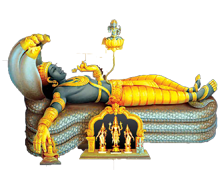
The merging of mythology and historical narrative in these legends enriches the temple’s significance, infusing it with layers of symbolic meaning and mystical resonance. Elements such as the deity’s playful guise, the sage’s devotion, and the miraculous transformation underscore the temple’s sacred aura and enduring appeal to devotees.
These legends, passed down through generations via oral tradition and religious texts, contribute to the cultural heritage and spiritual identity associated with the Padmanabhaswamy Temple. By recounting these tales, devotees reaffirm their connection to the temple’s divine origins and the enduring presence of Vishnu’s grace within its sacred precincts.
IV. Temple’s Administration and Protection:
Legend has it that Parasurama entrusted the administration of the Padmanabhaswamy Temple to seven Potti families, including Koopakkara Potti, Vanchiyoor Athiyara Potti, and others. Additionally, King Adithya Vikrama of Vanchi (Venad) was tasked with the protection (‘Paripalanam’) of the temple, highlighting the divine mandate for safeguarding its sanctity. Parasurama reportedly entrusted the Tantram (religious rituals and practices) of the temple to Tharananallur Namboothiripad, ensuring the continuity of sacred traditions and rituals. This transmission of spiritual knowledge underscores the temple’s lineage and the importance of preserving its religious heritage.
According to tradition, the establishment of the temple was facilitated with the support of the reigning king and Brahmin households. The involvement of royal patronage and community participation reflects the collaborative efforts to build and maintain the temple as a center of religious devotion and cultural significance.
These narratives blend mythological elements with historical accounts, illustrating the intersection of divine intervention and human agency in the temple’s establishment and governance. Through the interplay of legend and historical records, the temple emerges as a focal point of religious authority and communal cohesion within the broader socio-political landscape.
The transmission of administrative responsibilities and religious practices from ancient times to the present underscores the enduring legacy and continuity of tradition associated with the Padmanabhaswamy Temple. By upholding these rituals and customs, successive generations of priests, devotees, and custodians contribute to the temple’s spiritual vitality and cultural resilience.
V. Historical Events and Divine Intervention:
In 1680 AD, Mukilan, a Muslim marauder, invaded the Venad region, causing widespread destruction, including the Budhapuram Bhaktadasa Perumal Temple owned by Neythasseri Potti. Mukilan’s intentions to plunder the vaults of the Padmanabhaswamy Temple and destroy it were thwarted by local Muslims loyal to the Venad royals. Padmanabhan Thampi, an adversary of Anizhom Thirunal Marthanda Varma, attempted to loot the temple vaults, staying at Sri Varaham and sending mercenaries to carry out the task. However, divine serpents materialized, frightening away Thampi’s men and preventing the desecration of the temple’s treasures.
The appearance of divine serpents during Thampi’s incursion is interpreted as a miraculous intervention to protect the temple’s sanctity and treasures. This event bolstered the local populace’s resolve to defend the temple against external threats and preserve its religious and cultural heritage.
Pallichal Pillai and local inhabitants opposed Thampi’s looting attempt, demonstrating their commitment to safeguarding the temple’s assets and sanctity. Through collective action and divine intervention, the temple was shielded from external aggression, reaffirming its status as a sacred sanctuary deserving of reverence and protection. These historical events, intertwined with legends of divine intervention, contribute to the cultural legacy and significance of the Padmanabhaswamy Temple. They serve as reminders of the temple’s resilience in the face of adversity and the enduring devotion of its custodians and devotees in preserving its sacred legacy for future generations.
Temple Structure
Main Shrine:

In the inner sanctum, Padmanabha is depicted reclining upon the serpent Anantha or Adi Sesha, with its five hoods turned inward, symbolizing deep contemplation. Positioned beside Padmanabha are his consorts, Sridevi-Lakshmi, the Goddess of Prosperity, and Bhudevi, the Goddess of Earth. Additionally, Brahma emerges from a lotus that originates from the deity’s navel. The idol of Padmanabha is sculpted from 12,008 saligramams, sourced from the banks of the Gandaki River in Nepal. Rituals formerly conducted at the Pashupatinath Temple in Nepal to honor the deity’s origin are commemorated. The idol of Padmanabha is meticulously coated with “Katusarkara yogam,” an Ayurvedic mixture made from 108 natural materials, providing a protective layer. Daily worship rituals involve the offering of flowers, while special deities are used during the abhishekam ceremony.
Ottakkal-mandapam:
The Ottakkal-mandapam serves as platforms located in front of the vimanam and where the deity is positioned. It was commissioned by Marthanda Varma and sculpted from a single massive stone, extracted from Thirumala and transported to the temple. Additionally, 12,000 shaligrams, aniconic representations of Vishnu, were brought from the Gandaki River to be used in the temple’s reconsecration. The Ottakkal-mandapam enables devotees to have darshan and perform puja rituals. Specifically, only the King of Travancore is permitted to prostrate on the Ottakkal Mandapam as a symbolic gesture of surrendering all possessions to the deity.
Darshan and Puja:
To have darshan and perform puja rituals, one must ascend to the mandapam within the temple. Through three distinct doors, devotees can behold different aspects of the deity and accompanying figures. The first door grants a view of the reclining Padmanabha and the Shiva lingam beneath his hand. The second door reveals Sridevi and Bhrigu Muni in Katusarkara, Brahma seated on a lotus emerging from the deity’s navel, along with gold abhisheka moorthies of Padmanabha, Sridevi, and Bhudevi, and a silver utsava moorthi of Padmanabha. Finally, the third door allows a glimpse of the deity’s feet, along with Bhudevi and Markandeya Muni in Katusarkara. It’s noteworthy that only the King of Travancore is allowed to prostrate on the Ottakkal Mandapam, as it symbolizes surrendering all possessions to the deity.
Other Shrines:
Within the temple premises, there are two significant shrines: Thekkedom and Thiruvambadi, dedicated to Ugra Narasimha and Krishna Swami, respectively. Centuries ago, families of Vrishni Kshatriyas brought idols of Balarama and Krishna to the south. The Balarama idol, also known as Bhaktadasa, was given to Neythasseri Potti, who built a temple for it at Budhapuram in present-day Kanyakumari District. The idol of Krishna was presented to Maharaja Udaya Marthanda Varma of Venad, who established the Thiruvambadi shrine within the Padmanabhaswamy Temple premises. Thiruvambadi shrine holds an independent status, with its own namaskara mandapam, bali stones, and flagmast. The deity worshipped in Thiruvambadi is Parthasarathi, the Divine Charioteer of Arjuna in the Mahabharata, depicted in a standing posture with one hand holding a whip and the other resting on the left thigh holding a conch. On Ekadashi days, the deity is adorned as Mohini. The settlers from the Vrishni lineage, known as Krishnan Vakakkar, are credited with introducing these deities to the region. Additionally, there are shrines dedicated to Rama, Sita, Lakshmana, Hanuman, Vishvaksena, Vyasa, Ashwatthama, Ganapati, Sasta, and Kshetrapala, along with grand idols of Garuda and Hanuman in the Valiya balikkal area. The thevara idols of Chithira Thirunal Balarama Varma and Uthradom Thirunal Marthanda Varma are housed in the southeast part of the temple.
Gopuram and Surroundings:
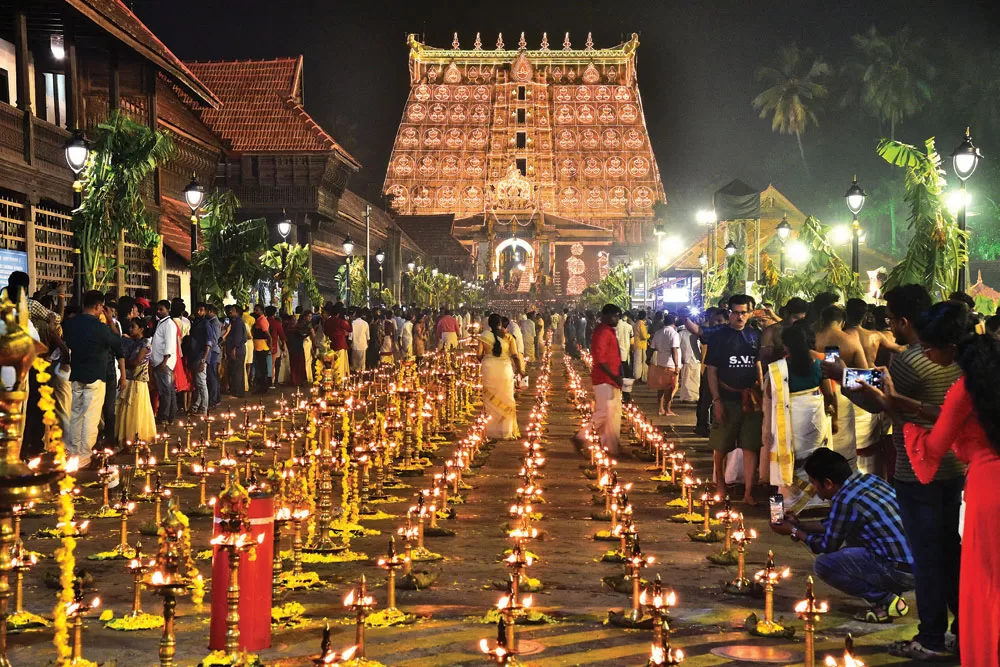
The foundation of the present gopuram was laid in 1566, featuring a 7-tier structure built in the Pandyan architectural style, towering 100 feet high. Situated adjacent to a tank called Padma Theertham, the temple boasts a corridor adorned with 365 intricately sculpted granite pillars, showcasing the skill of Vishvakarma sthapathis. This corridor extends from the eastern side into the sanctum sanctorum. Standing before the main entry is an 80-foot flagstaff. Below the gopuram, the ground floor serves as the Nataka Sala, where performances of Kathakali were once held during the temple’s festivals, which occur twice a year in the Malayalam months of Meenam and Thulam.
Sree Padmanabhaswamy Temple Dress Code
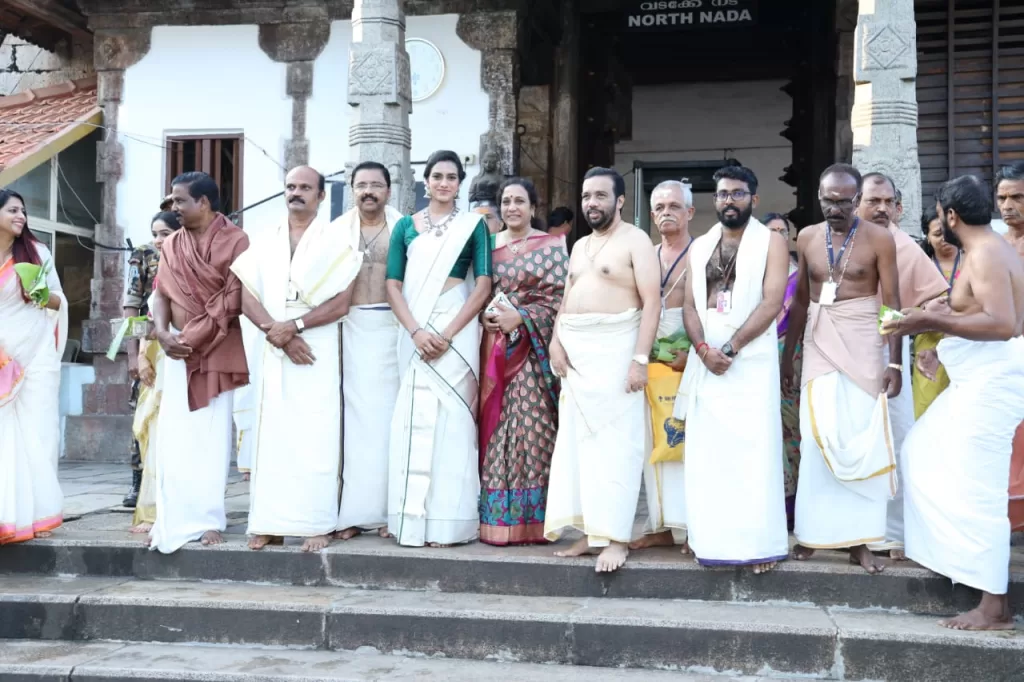
Dress code to be followed at the temple:
Only Hindus are permitted inside the temple.
There is a strict dress code that needs to be followed while entering the temple. Men need to wear mundu or dhoti (worn around the waist and going down up to the heels) and should not wear shirts of any kind.
Women need to wear sari, mundum neriyathum (set-mundu), skirt and blouse, or half sari.
Dhotis are available for rent at the temple entrance. Nowadays temple authorities allow wearing of dhotis over pants or churidhar to avoid inconvenience to the devotees.
Sree Padmanabhaswamy Temple Timings
Sree Padmanabhaswamy Darshan Timings
Morning hours:
03:30 a.m. to 04:45 a.m. (Nirmalya Darshanam)
06:30 a.m. to 07:00 a.m.
8.30 a.m. to 10:00 a.m.
10:30 a.m. to 11:10 a.m.
11:45 a.m. to 12:00 Noon
Evening hours:
05:00 p.m. to 06:15 p.m.
06:45 p.m. to 07:20 p.m.
Please note that the temple worship timings are subject to change during the festival occasion.

